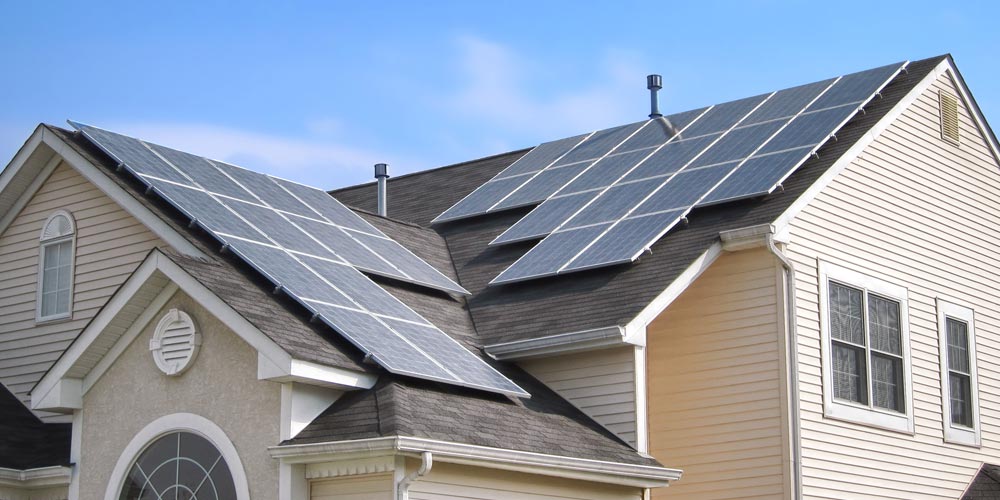
South-facing solar panels are the best option for the vast majority of homeowners.
In this blog, we’ll explain why south is the best direction for achieving the goals you’re likely to have for your solar panels.
We’ll also discuss what happens if you can’t point your solar panels south, and turn them another way instead.
Key takeaways
- In the U.S. solar panels perform the best – that is, generate the most power – when they face south.
- South-facing panels are also best if you use net metering or use solar batteries for energy storage.
- Panels turned away from the south generate less power – about 15% less when facing east or west, and around 30% less if facing north.
- If you have Time of Use (TOU) electric billing with exorbitantly high peak rates, you may benefit from having your panels point southwest.
Best solar panel direction for every goal
Here is a summary of the best solar panel direction for every use case.
| Your goal | Best direction |
|---|---|
| Maximize solar power output | South |
| Take full advantage of net metering for bill savings | South |
| Use a solar battery and reduce your grid reliance | South |
| Minimize the impact of high Time of Use (TOU) rates | South or southwest |
Explanations are provided below.
Best solar panel direction overall
South is the best direction for solar panels to face overall.
In nearly all situations, you will see the greatest utility bill savings and quickest payback period if your panels point south instead of in another direction.
South-facing panels have superior economics for the following reasons:
- They generate more solar energy
- They allow you to gain the greatest benefit from net metering
- They allow for better solar battery utilization.
We explore each of these reasons in more detail below.
South is best for maximizing solar panel output
In the U.S., solar panels generate the most power when they face south.
The sun’s path means that it shines above the Equator, or close to that point. Its path never moves north of the Tropic of Cancer (23.4°N Latitude). Anyone living in the mainland U.S. is located north of that line, and for them the sun remains in the southern half of the sky all year round.
When you keep your solar panels facing south, they are essentially facing the sun all year long, allowing them to receive the most sunlight possible.
Pictured: Even during the summer solstice (June 21) – when the sun’s path reaches its northernmost point over the Tropic of Cancer (23.4°N Latitude) – it remains to the south of the mainland U.S.
South is best for homes with net metering
If you’re in a location with net metering, the best direction for your solar panels is south.
Solar panels that face south generate lots of power, with the bulk of it produced around midday
While household energy usage tends to be lowest around that time, you’ll be left with lots of excess solar power. When you have net metering, surplus power is a good thing, as you can export it to the grid in return for generous compensation from your utility.
Learn more: What is net metering and how does it work?
South is best with solar batteries
South-facing panels are best if you plan to install a battery storage system such as the Tesla Powerwall or sonnen Eco.
The higher power output of south-facing panels means they can provide you with plenty of power to charge up your solar batteries, even after meeting your home’s daytime energy needs.
The power stored in your solar battery will come in handy later, supplying your home with energy during the night and providing you with backup power in the event of a grid outage.
South to southwest is best for TOU rates
Orienting your solar panels between south and southwest is best if your utility uses Time of Use (TOU) billing.
Where TOU billing is in place, utilities charge higher rates for electricity at certain times, usually in the form of peak rates, from 4 PM onwards.
Since utility power is so expensive later in the day under TOU, any solar power you can generate for yourself during those hours becomes more valuable.
You can increase your solar power production in the afternoon and evenings by facing your solar panels southwest, allowing them to receive more light from the setting sun.
The trade-off? Southwest-facing solar panels produce less solar power overall over the course of the day.
So should you point your solar panels southwest if you have TOU billing rates? Solar software designer Aurora Solar did a case study on the topic, and here’s what they found:
- Where peak electricity rates are twice as much (2x) as off-peak rates, the ideal solar panel orientation is very close to the south.
- If peak rates are extremely high – 3x your off-peak rates, or more – then solar panels should face southwest.
When peak electricity rates are 2x normal rates, the ideal orientation is very close to the south (see left-most image). However, once peak rates rise to 3x or 4x, the ideal orientation changes to the southwest. Image source: Aurora Solar
A solar installer can calculate the optimal orientation for solar panels on your roof based on TOU billing rates where you live.
Of course, we all have to work with the roof that we have, and you may or may not be able to achieve your desired solar panel orientation. So would a solar panel installation still be worth it for you? The easiest way to find out is with our solar calculator, which can estimate your solar panel costs and savings based on your roof direction and your utility’s TOU billing rates.
How much does solar panel direction impact output?
In the U.S., orienting solar panels true south (azimuth of 180 degrees solar noon) will result in maximum output. Face them any other direction, and you can expect to see a fall in solar panel output.
Solar panels see a drop in solar power production when you face them away from the true south. The size of the output drop will depend on where the solar panels are facing instead.
| Solar panel direction | Achievable output* | Change |
|---|---|---|
| Southwest or southeast | 92% | -8% |
| East or west | 85% | -15% |
| North | 70% | -30% |
*As compared to south-facing solar panels; figures are ballpark estimates only.
North, south, east or west, which direction do you like the best? When it comes to solar panels, the answer is definitely south. The graphic shows ballpark figures for the output losses experienced by pointing your panels in a direction other than south.
Panels facing southwest or southeast
Solar panels installed on a roof facing southwest or southeast will generally produce about 8% less power than the same panels in the same climate on a south-facing roof.
Panels facing east and west
Panels mounted on a standard pitch roof facing east or west will produce approximately 15% less output than panels facing south at the same pitch.
Panels facing north
Panels on a standard pitch roof facing north - that is, away from the sun - will produce roughly 30% less than panels facing south.
Explained: Impact of direction on solar panel output
Turning solar panels away from true south will generally result in output losses of less than 30%, but in some extreme cases losses of close to 60% may be seen.
The precise drop in energy production is determined by three factors:
- Distance from south: The number of degrees the panels are turned away from true south.
- Your latitude: How far north your home is located.
- The pitch of your roof: This determines how your solar panels will be angled towards the sun.
Distance from south
To state the obvious, the greater the turn away from the south, the bigger the loss in energy production. So a turn to the southwest will see a small drop, turning west will see a moderate drop, and turning north will see the biggest drop.
Latitude
When it comes to latitude, the further north you are, the bigger the fall in energy production when you turn away from south. All else equal, solar panels in Seattle, WA will see a much bigger output drop in non-south alignment than a home in Miami, FL.
Roof pitch
The steeper your roof, the bigger the output drop you’ll experience by having your solar panels face away from the south. For instance, in Charlotte, NC a roof with a pitch of 2/12 (9.5*) would see a 16% loss by turning its solar panels from south to north; a roof in the same location with a steeper pitch – 4/12 (18.4) – would see a much larger drop of 29%.
What if your roof doesn't face south?
Barring a couple of exceptions outlined above, your rooftop solar energy system should ideally be facing south for maximum efficiency. Of course, this isn’t always possible: many homeowners don’t have roofs that face in that direction!
The good news is that this is not a dealbreaker. There are plenty of homeowners without south-facing roofs, who have solar panels installed and are enjoying huge savings on their electric bills.
Here are some workarounds for homeowners who don’t have south-facing roofs:
Install solar panels on your roof anyway
You can compensate for the decreased level of sunlight by installing more solar panels. In a solar panel installation, the solar panels themselves only account for a small proportion of costs; you should be able to add a few extra panels without pushing up costs too much.
This is the option that most homeowners choose when they don’t have a roof section that faces south.
Install a solar array on the ground
You can also install a ground-mounted solar power system in your yard.
Ground-mounted solar panels allow you to position them for optimal angle and direction, maximizing your solar power output. They are also easier to maintain, as you can brush off leaves or snow without having to climb onto your roof.
The downside? Ground-mounted systems tend to be more expensive than rooftop solar panels, and they also take up lots of space on your property.
Utilize solar panel trackers
If your budget allows, consider solar panel tracking systems. They can improve a system’s output by ensuring constant, direct exposure to the sun, both during the day and across seasons. Axis trackers generate more electricity by using about the same amount of space as fixed systems.
However, it’s important to note that solar trackers are expensive. A standard 4 kW solar panel system costs you about $11,400 after incentives, but an equivalent axis-tracking system like the Smartflower costs about $20,000, or almost twice as much.
How to calculate output on your roof based on its direction
The easiest way to adjust for the impact of your roof’s direction (and tilt angle) on your potential solar panel output is by using the SolarReviews calculator.
The calculator gives us an accurate output from which we calculate the cost and savings you will get based on your local solar prices and the amount you pay your utility company for electricity.
